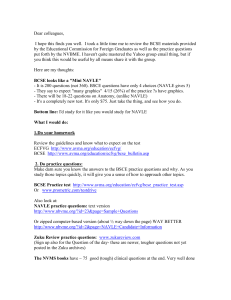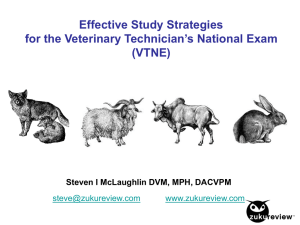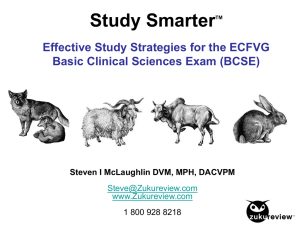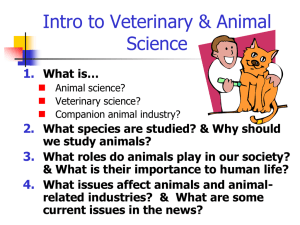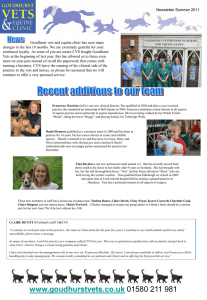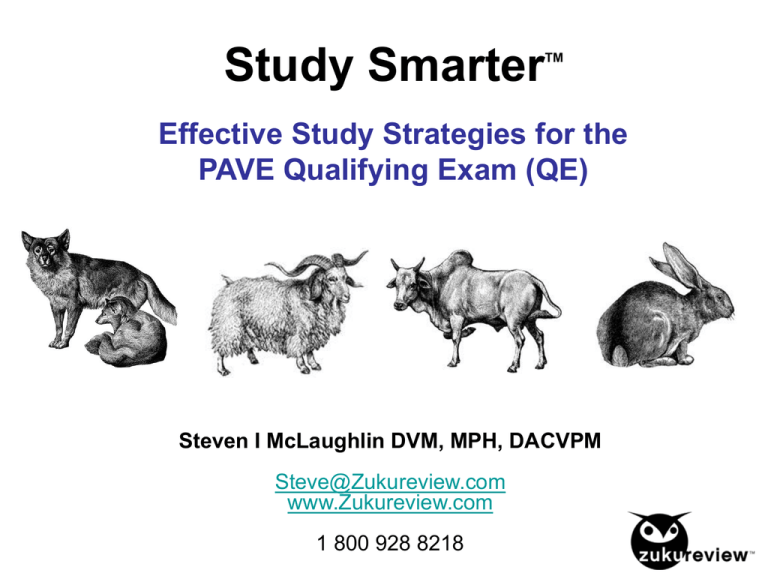
Study Smarter
TM
Effective Study Strategies for the
PAVE Qualifying Exam (QE)
Steven I McLaughlin DVM, MPH, DACVPM
Steve@Zukureview.com
www.Zukureview.com
1 800 928 8218
“It is not enough to be a good chess player,
you must also play well.”
-Savielly Tartakower
A Story
Once upon a time, there was a world called veterinary medicine,
covered in many forests.
One forest was called “Pharmacology”; another “Physiology” and
so on.
In the Pharmacology forest, there were many trees. One tree
was called “Antibiotics” and another called “Antiparasitics”.
On that antibiotics tree was a single leaf called “Rifampin”
One day, a good-hearted but near-sighted
vet student wandered into the pharmacology
forest, and got so engrossed studying a leaf
on a single tree that she got lost, and a big
bad wolf called PAVE QE came and ate her.
The End
The need for speed
It is time to go fast, people.
• The goal is not to know everything
• The goal is not to get every question right
• The goal is to pass
In the forests of knowledge, let this be your map
Today’s talk:
Program for the Assessment of Veterinary Education
Equivalence Qualifying Exam (PAVE QE)
• QE structure, pass rates
• Study strategies for QE
• Test-taking strategies for QE
QE Structure
• 300 questions, takes all day
• Two 150-question blocks
–
–
–
–
165 minutes per block (almost 3 hours!)
~1 minute per question
10% of questions have images
Typically, 15-20 questions not counted during scoring
• Breaks
– No break once you start a block
– 45 minute break between blocks
– If finish block early, get extra break time
Pop Quiz
What percentage of students taking QE for the first
time pass ?
(A) 58%
(B) 69%
(C) 70%
(D) 78%
(E) 89%
70% (212/303) of candidates taking QE for the first time PASSED on the
Sep 07’ Jan, May 08’ test dates.
PAVE QE Technical Report, 2007-8 (most recent data available as of 24 July, 2009)
http://nbvme.org/components/get_file.php?mid=164&fn=QEreport07-08.pdf/QEreport07-08.pdf
For other years, see QE technical Reports webpage http://www.nbvme.org/?id=61
QE Pass Rates and Trends
Took QE
Pass (%)
Sep 05’, 299 (all)
Jan, May
06’
270 (1st attempt)
230 (77%)
Take home:
216 (80%)
More people
failing QE
Sep 07’, 398(all)
Jan, May
08’
303 (1st attempt)
252 (63%)
212 (70%)
30-person increase in 1st-timers, but…
100-person increase overall
Source: QE technical Reports webpage http://www.nbvme.org/?id=61
More people
re-taking QE
Why bother to study effectively?
• QE is foundational knowledge
– Concepts support your NAVLE prep
– AND help you in clinics
• Use motivation of QE to learn how to learn
(This isn’t the last test you’ll ever take….)
• Who wants to pay another $800?
Example of a QE question
Which stage of the canine estrous cycle is
indicated by nonnucleated epithelial cells in
a vaginal smear?
Remember: "CORNflakes go with MILK."
(A) Late diestrus
(B) Late estrus
(C) Early diestrus
(D) Early proestrus
(E) Anestrus
Think > 90% CORNified, superficial cells in canine
estrus (angular, sharp edges like corn flakes, tiny
pyknotic nuclei or no nuclei, no neutrophils).
Full cornification usually coincides with receptivity.
Follow this link to see a vaginal smear from a dog in
estrus
http://www.merckvetmanual.com/mvm/htm/bc/mgnrs905.htm
and in diestrus
http://www.merckvetmanual.com/mvm/htm/bc/mgnrs903.htm
Sources: PAVE QE practice test http://www.nbvme.org/?id=35&page=QE+Sample+Questions
The Merck Vet Manual online http://www.merckvetmanual.com/mvm/index.jsp?cfile=htm/bc/181903.htm
Example of a NAVLE-style question
You are assisting a dog breeder decide when to breed
her prize Siberian mousehound.
A vaginal smear looks like this:
http://www.merckvetmanual.com/mvm/htm/bc/z-mgnrs905.htm
What would you recommend to the owner?
(A) Cannot say from this slide
(B) Cannot say with only one smear
(C) Breed the dog today
(D) We missed her estrus, wait 2 months
(E) Not in heat yet
Source: The Zuku Review, online veterinary test prep
http://zukureview.com/index.php and the Merck Manual online
Worth Remembering on Test Day
• Show up 30 minutes early
– Must have photo-i.d. to enter
– Must have Authorization letter
– Authorization letter arrives 5 weeks before QE, has test address
• No personal belongings allowed in test room
– No calculator, cell phone or digital watch
– No food or drink
– No backpack, brimmed hats, purse or coat
• What is allowed ?
– Erasable whiteboard provided for calculations
– Some people bring earplugs
QE Topics:
Not exactly “laser focused”
1)
2)
3)
4)
5)
Anatomy
Physiology
Pharmacology
Microbiology
Pathology
59%, ~ 2/3 of test
“The QE is not designed to measure your ability to
make diagnoses or manage clinical cases.”
NBVME QE Candidate Bulletin,
http://www.aavsb.org/PAVE/2007-08QEbulletin.pdf
QE Subtopics
Normal Animal, 59% of test
Anatomy, 23%
Incl. micro-anatomy, radiology, diagnostic imaging
Physiology, 23%
Incl. physiochem/biochem, neurobiology, genetics
Incl. endocrinology, reproduction, nutrition
Pharmacology, 13%
Incl. anesthesiology
Abnormal animal, 41% of test
Microbiology, 20%
Got all that?
Piece of cake,
right?
Incl. bacteriology, virology, mycology, parasitology
Incl. immunology, public health, food safety, epidemiology
Pathology, 21%
Incl. clinical pathology, toxicology
If the PAVE QE test is so broad,
where do I start?
Be guided by QE sample questions
http://www.nbvme.org/?id=35&page=QE+Sample+Questions
– A springboard to study
– A pointer to key topics
– Gives you a sense of the depth, style of questions
Note: BCSE questions are similar to the QE.
For more practice, try the BCSE practice test .
http://www.avma.org/education/ecfvg/bcse_practice_test.asp
Where to start? An example
Which of the following changes occurs as
a result of metabolic acidosis?
(A) Oxygen-hemoglobin saturation curve shifts to the left
(B) Plasma becomes hypotonic
(C) Plasma ionized calcium concentration increases
(D) Serum glucose concentration increases
(E) Serum potassium concentrations decreases
Suggests “physiology & acid base” worth a review
Source: PAVE QE practice test http://www.nbvme.org/?id=35&page=QE+Sample+Questions
Where to start? Another example
Which of the following is the most likely finding
on a leukogram from a cow with a large
chronic abscess?
(A) Monocytosis with left shift and toxic change
(B) Neutropenia and eosinopenia
(C) Neutropenia and monocytosis
(D) Neutropenia with left shift and toxic change
(E) Neutrophilia and monocytosis
Suggests “Clin Path / white cell function” worth a review
Source: PAVE QE practice test http://www.nbvme.org/?id=35&page=QE+Sample+Questions
Study Smarter
TM
“Successful learning is not measured by how
many hours you study.
Successful learning means using the hours
you do have effectively.”
-Dr. Zuku
(Steven I Mclaughlin DVM, MPH, DACVPM)
A study technique that
doesn’t work
“I spent 6 hours reading endocrinology
on Saturday,…..
But Monday, I didn’t remember any of it !”
“Reading = Learning”
USE IT OR LOSE IT
• MOST adults forget 50% of what they just read
• And 80% within 24 hours
BUT !!
• Anything you have studied well will come back
very quickly with a review
….if you make good notes
Another study technique that
doesn’t work
Treating every single factoid as if it
were important
Ref: Dyce, Sack and Wensing Textbook of Veterinary Anatomy
No “take home message” here!
Learn to recognize the most important 3 points
Study Smarter
TM
• Start with a calendar
– Map out your study plan, week by week
– Make test prep part of your routine
• First Pass: finish 3 weeks before test
– All study-mode tests
– Write out summary notes
• Second Pass: during the 3 weeks before test
– All test-mode tests
– Review summary notes
Study strategies for QE
The 50:50 rule
Study ~50%
Practice testing ~50%
-Map out the topic
-Hit the books
-Write summary notes
-REVIEW those NOTES
-ROUTINE
a couple times a week
Goal: Finish study-mode tests, complete summary
notes 3 weeks before the test
PAVE QE Study Plan:
First Pass
Monday:
Tests: ClinAnat #1,DxImaging #1,Pharm #1,Surg#1, Physio #1 etc. Note mistakes. ~1 hr
Study: Quick read of 5 key disease topics ~ 1 hour
Tuesday:
Tests: Do My Missed Questions from yesterday to reinforce
Start new tests- ClinAnat #2,DxImaging #2,Pharm #2,Surg#2, Physio #2 etc.
Study: Write summary notes on the 5 topics ~ 2 hours
Wednesday:
Tests: Do My Missed Questions from yesterday to reinforce
Start new tests-ClinAnat #3,DxImaging #3,Pharm #3,Surg#3, Physio #3 etc.
Study: Quick review of summary notes from Tuesday
Quick read of 5 new disease topics ~ 1 hour
…………..etc
Summary notes: 50% of your time
• Why write summary notes?
– Translates info into language your brain understands
– Customized notes worth weight in gold in weeks before test
• Map out the topic
– DON’T reinvent the wheel
– Use textbook table of contents or class syllabus
• The rule of 5- never more then 5 ideas per topic
• Add “Mental Velcro”
– Images
– Disease examples
Mental velcro: Images
A picture IS worth a thousand words:
Add pictures to your notes
Fluid-filled lungs: Pulmonary edema
“Floating lungs”: Pleural effusion
Images courtesy of Dr. Terri Defrancesco, DVM, ACVIM,
All rights reserved, copyright 2007-2010
Mental velcro: Disease
Horner’s Syndrome:
Remember "My 3rd Sunken Toe“
(Miosis, 3rd lid protrudes, Sunken
eye, Ptosis) and "sweaty horses".
A syndrome, not a disease per se.
What is it?
Image courtesy,
Dr. Joel Mills, Wikimedia Commons
See 4 things with Horner's, ALL
associated with the eye:
1. MIOSIS (constricted pupil-lose
sympathetic innervation)
2. PROTRUSION 3rd eyelid
(nictitans)
3. ENOPTHALMOS (sunken eye)
4. PTOSIS (drooped eyelid), +/anisocoria
http://commons.wikimedia.org/wiki/File:Horner%
27s_syndrome_dog.JPG
Map Out Your Topic
You are on the ground
in the forest of “Pharmacology”,
looking at a tree called “Misc antibiotics”
and a leaf called “Rifampin”.
To figure out where you are
(and to get where you want to go),
Visualize where you are from 10,000 feet up
Map example: Pharmacology
Map from 10,000 feet
Map from 1000 feet
5 “Antis”
Antibacterials
Antifungals
Antiparasitics
Antivirals
Antineoplastics
I. Antibacterials
A. ‘cidals
B. ‘statics
C. Misc antibiotics
5 “keys”
Key Cardio drugs
Key Optho drugs
Key Repro drugs
Key Endo drugs
Key Renal drugs
Misc
Key antidotes/tox reversal agents
Analgesics
Tranquilizers
Map from 100 feet
C. Misc antibiotics
1. Chloramphenicol
2. Rifampin
3. Metronidazole
Map on the ground
You are here
2. Rifampin
a. Gen info
b. Primary use
c. Contraindications
d. Cautions
e. “mental velcro” (Image, disease)
Summary notes part 1: Pharmacology, Rifampin
2. Rifampin
a.General-‘cidal or ‘static dep. on microbe
b.Primary use -Rx Rhodococcus equi, young horses
c.Contraindication -Beware in hypersens animals, hepatic dysfxn
d.Caution
1). May cz red-orange urine, tears, sweat
2). Don’t use alone or see rapid resistance
3). Give on empty stomach
e.Mental velcro- Rhodococcus equi
References: Plumb’s Vet Drug Formulary 5th ed. pp.992-4,
Merck Vet Manual online, http://www.merckvetmanual.com/mvm/index.jsp?cfile=htm/bc/191282.htm
Summary notes part 2: Rifampin
Mental velcro (image and a disease)
References: Pasquini, Pasquini & Woods, Guide to Equine Clinics, 3rd ed. p. 113
Notes developed by senior veterinary student for educational use preparation for NAVLE
Image courtesy, Angeline Warner, DVM, D. Sc: http://ocw.tufts.edu/Content/27/imagegallery/367446/367480
Where to get a fast disease summary
From: Pasquini, Pasquini & Woods, Guide to Equine Clinics, 3rd ed. p. 113
Outside a dog, a book is a man’s best friend.
Inside a dog, it’s too dark to read.
- Groucho Marx
If you believe everything you read, better not read.
- Japanese proverb
Recommended books for QE
For medicine and disease summaries:
Bovine: *Guide to Bovine Clinics 4th edition—Chris & Susan Pasquini
Equine: *Guide to Equine Clinics 3rd edition—Chris & Susan Pasquini, Phil Woods
Dogs and Cats:
*Veterinary Clinical Advisor, Dogs and Cats, 1st ed. Cote' ed.
*Tschauner's Guide to Small Animal Clinics 2nd ed.—Chris & Susan Pasquini
Blackwell's 5 Minute Veterinary Consult, Canine-Feline 4th ed. Tilley & Smith eds.
Clinical Anatomy: Anatomy of Domestic Animals 10th edition— Pasquini, Spurgeon and Pasquini
– On almost every page you find a box that tells the clinical significance, diseases associated
with that part. Superb. Study those. Make short notes. Go fast.
Pharmacology: *Plumb’s Veterinary Drug Handbook, 5th edition, Donald C. Plumb
– The original and a favorite, available as a book or online through VIN
Physiology: Veterinary Physiology, 4th ed. Cunningham and Klein
– Good case-based organization, FAR easier to navigate than Duke’s
Clinical Pathology: Duncan and Prasse's Clinical Pathology, 4th ed.
– 35 excellent case studies in appendix. We like this one, but other texts are also good.
Anesthesia, dentistry, basic surgery: Clinical Textbook for Vet Techs, 7th ed, McCurnin & Bassert
– Great images, good tune up on basics.
*Zuku Review Pick of the Litter
TM
Practice testing for PAVE QE:
50% of your time
“You don't get ready for a marathon by
reading a book about it.
You put on your running shoes and run.”
-Dr. Zuku
Multiple choice tricks of the trade
• The Good News
Correct answer is GUARANTEED to be among the choices
• The Bad News
You WILL hit questions you don’t know
Common mistake: Spending MOST of your time on
questions about which you know the LEAST.
• Key to success:
Train yourself to MAKE CHOICES and then MOVE ON.
Multiple choice tricks of the trade
• READ the question first (DON’T look at answers)
• PREDICT the answer
(protects you from distractors)
• Is your answer the best of the choices ?
If “Yes” SELECT it and move on
• Unsure of the correct answer ?
ELIMINATE wrong ones, choose from what’s left,
and MOVE ON
“What if I don’t think this system will work for me ?”
Do what works for you.
“How do I know when I should I change an answer ?”
Stick with your first answer unless you recognize that it
is clearly not correct - studies show that changed answers
are more frequently wrong.
“I am clueless about chickens/cardiology/box turtle
halitosis, what do I do?”
Read, Predict, Eliminate, Select -The correct answer is
guaranteed to be among the choices. Whittle the
choices down to as few as possible and guess.
The 24-hour “golden period” of
short-term memory
• A mistake is the best teacher
– Mistakes sting
– Sting helps you remember,
…...IF you redo missed question within 24 hrs
• After 24 hours, most new info fades from memory
• Note questions you miss today on scratch paper
• Redo “Missed Questions” tomorrow
– Reinforces weak areas fast
Sources of practice questions
• QE sample test
http://www.nbvme.org/?id=35&page=QE+Sample+Questions
• BCSE sample test (similar to QE)
http://www.prometric.com/Demos/AVMA/index.htm
• Vet Board Games cards
http://www.veterinaryboardgames.com/
• Zuku review QE course & Question Archive
http://zukureview.com/QOD_Archive.PHP
• CAPC parasitology test
http://www.capcvet.org/other/resources.html
• Mosby’s Basic and Clin sciences questions
Pop Quiz
What is a Cook's speculum?
A)
B)
C)
D)
Three-pronged ear speculum
Four-pronged rectal speculum
Three-pronged nasal speculum
Three-pronged rectal speculum
Multiple choice tricks of the trade:
Convergence
What is a Cook's speculum?
A)
B)
C)
D)
Three-pronged ear speculum
Four-pronged rectal speculum
Three-pronged nasal speculum
Three-pronged rectal speculum
This is an example of convergence.
Options A, C and D all contain the words "three-pronged“
Options B and D both contain the word "rectal."
These two sets converge at option D
Adapted from: Leo M. Harvill, Ph.D. “The Test Of Obscure Medical Information”
Multiple choice tricks of the trade:
Prognosis
Questions about prognosis tend to be all or nothing
(ie: clearly GREAT or clearly HORRIBLE)
Prognosis/success rates by percentage:
Excellent
Good
Guarded/Fair
Poor
Grave
90-100%
65-89%
35-64%
11-34%
1-10%
(ave: 95%)
(ave: 75%)
(ave: 50%)
(ave: 25%)
(ave: 5%)
Ref: Pasquini's, Tschauner's Guide to Sm. An Clinics, vol 1, 2nd ed. p. 11
Multiple choice tricks of the trade
Images
• CENTER
Most photographers put lesion centrally in photos
• Radiographs are an exception
– Must look over WHOLE x-ray
– History gives clues
• Hit by car? Check for pelvic or femoral fracture, dislocation,
Check for diaphragmatic hernia (bowel loop in chest)
• Straining to urinate? Check bladder for stones
• Regurgitation? Check for lung field for megaesophagus
• No normals- Good images are hard to get.
UNLIKELY to see picture with nothing wrong
If there is a problem in this
picture, where is it ?
(click link)
http://www.merckvetmanual.com/mvm/htm/bc/z-exlha29.htm
Intussusception, Hamster, center of image
Click this version for explanatory text:
http://www.merckvetmanual.com/mvm/htm/bc/z-exlha29.htm
Reference: The Merck Veterinary Manual online edition
http://www.merckvetmanual.com/mvm/index.jsp
Where is the problem?
Image courtesy,
Dr. Peter Schantz
Tongue ulcer, canine leishmaniasis
Where is the problem?
Image courtesy,
Dr. Kim Stanz
What is it?
Ulcer, possible descemetocoele
Where is the problem?
Image courtesy,
Dr. Terri
Defrancesco
What is it?
Endocardiosis, mitral valve
What, if anything, is wrong with this picture?
History
Hint:
This cat is
having
urinary
accidents
Bladder stones
Image courtesy,
Dr. Scot Nachbar
If anything is wrong with this picture,
in which quadrant is the problem?
History
Hint:
This beagle
was hit by a car
Upper left quadrant, Ilial fracture
Image courtesy,
Dr. Scot Nachbar
What, if anything, is wrong with this picture?
History
Hint:
This 6 month
old Labrador
regurgitates
soon after
eating
Megaesophagus: note ventral deviation
of tracheal carina, dilation of esophagus
Image courtesy,
Dr. Terri Defrancesco
Online Case Study & Image Resources
Surgery case studies
http://www.acvs.org/AnimalOwners/HealthConditions/
Radiology case studies
http://www.vet.k-state.edu/depts/VMTH/radiology/cow/index.htm
Radiology artifacts
http://vet.osu.edu/index.php?id=2355
Tech hint:
Clin Path Case studies
http://www.medvet.umontreal.ca/clinpath/choice.htm
Clin Path images
http://www.medvet.umontreal.ca/clinpath/banq-im/menuE.htm
Pathology/Histopathology images http://w3.vet.cornell.edu/nst/nst.asp
Right-click
your mouse
over an
internet image,
to copy and
paste it
elsewhere
Vet video library: www.vetvideos.com
Merck images online
http://www.merckvetmanual.com/mvm/index.jsp?cfile=htm/bc/mvm_list_img.htm
The final 3 weeks
Second Pass
“In the final weeks before a big race, you
change your training to mimic the race.
In the final weeks before test day,
change your study to mimic the real test”
-Dr. Zuku
The final 3 weeks
Second Pass
Study
-REVIEW your notes
-Skim misc topics not in notes
-Test yourself with flashcards,
friends, game cards
Practice testing
Do timed test-mode tests
-60-question tests build stamina
-Random topics
-No answers as you go
-Mimics the real thing
Goal: Finish all test-mode tests
Redo “Missed questions” within 24 hours
Review summary notes until solid in your mind
The final 3 weeks
Keep a routine
• Get regular exercise
…Run, swim, square-dance, walk your dog, hamster or wombat
• Get up early every day,
….about same time you need to wake up on test day
• Start with a decent breakfast
• Go immediately into 2 hours of practice tests, then notes review
• Get your mind & body into a routine so the big day feels routine too
• Don't give up.
• On test day, walk in with your head held high,
and take it one question at a time
Remember 4 things
1.
~50% study, ~50% practice testing
2.
Redo “missed questions” w/in 24 hours
3.
Try to finish first pass on summary notes &
study-mode tests 3 weeks before test
4.
In final 3 weeks do test-mode tests, review notes
If Time is Short
• ~1/3 time reviewing notes
• ~2/3 time taking tests
– Read, Predict, Select, or Eliminate
– Redo "My Missed Questions“ w/in 24 hours
– Pay attention to images in questions
– Finish all test-mode tests in final week
• Stay Positive
– Panic is not productive; don’t waste energy on it
– Test-takers with forward momentum and a positive attitude do
better on tests
– Do what you can, keep moving, and don't give up
Good luck!
“No student knows his subject:
the most he knows is where and how to find out the
things he does not know.”
–Woodrow Wilson
References
The summary of multiple choice strategies comes principally from:
“What Smart Students Know” by Adam Robinson, co-founder of The Princeton Review
test preparation company
George Washington University Academic Success Center- “Strategies for Multiple Choice
Questions”
Kaplan Test Prep US Medical Licensure Exam (USMLE) Strategy Sessions
Convergence concept Adapted from: “The Test Of Obscure Medical Information”
Leo M. Harvill, Ph.D.
NBVME QE Candidate Bulletin http://www.aavsb.org/PAVE/2007-08QEbulletin.pdf
PAVE QE score reports http://www.nbvme.org/?id=61
PAVE QE practice tests
Text version: http://www.nbvme.org/?id=35&page=QE+Sample+Questions
Web version: http://nbvmepractice.starttest.com/
BCSE practice test http://www.avma.org/education/ecfvg/bcse_practice_test.asp
Extra slides
Another example of good notes
References: Cote’, Veterinary Clinical Advisor, Dogs and Cats, 1st ed, pp. 259-60 &
Pasquini& Pasquini, Tschauner’s Guide to Small Animal Clinics, 2nd ed. p. 703
Notes developed by senior veterinary student for educational use preparation for NAVLE
Image source unreferenced. May be used only for educational purposes
Another Example of Convergence
Budin's rule states that the amount of cow's milk
consumed per day for a bottle-fed baby should be
approximately
of the weight of the baby.
A)
B)
C)
D)
1/10
1/8
1/7
2/10
Multiple choice tricks of the trade:
Convergence
Budin's rule states that the amount of cow's milk consumed per day for a
bottle-fed baby should be approximately
of the weight of the baby.
A)
B)
C)
D)
1/10
1/8
1/7
2/10
A, B and C are similar: they have “1” in the numerator;
A and D are similar: they have “10” in the denominator.
A test-wise examinee will choose A because it appears in
both sets above. The correct answer is A.
Adapted from: Leo M. Harvill, Ph.D. “The Test Of Obscure Medical Information”

